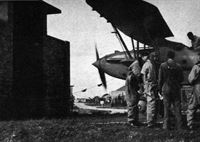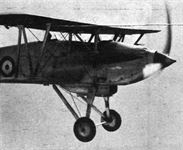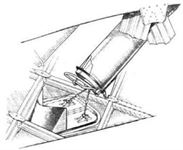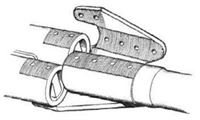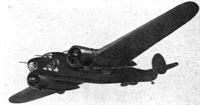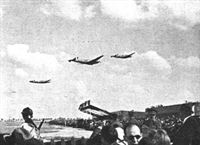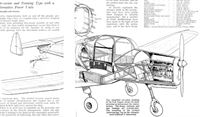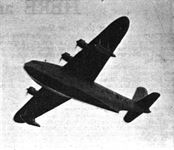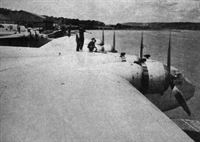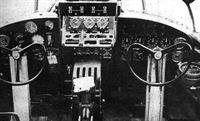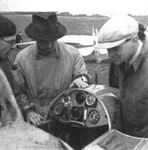Фотографии
-
A Merlin installed in an Armstrong Whitworth Whitley IV bomber. This aircraft is a standard type in the R.A.F.
Самолёты на фотографии: Armstrong Whitworth Whitley / A.W.38 - Великобритания - 1936
-
Fiat C.R.32 single-seater fighter (Italy).
Самолёты на фотографии: FIAT CR.30 / CR.32 Chirri - Италия - 1932
-
A DORNIER DEVELOPMENT: The Dornier Do. 215 which has been developed from the Do.17 and is said to be faster.
Самолёты на фотографии: Dornier Do.17Z / Do.215 - Германия - 1939
-
DORNIER DO 23. Shown here with air-cooled radials, this large military flying boat is believed to be used with liquid-cooled engines. The guns are mounted in turrets and defensive armament is installed in the extreme tail.
Самолёты на фотографии: Dornier Do.24 - Германия - 1937
-
Fiat G.50 single-seater fighter (Italy).
Самолёты на фотографии: FIAT G.50 Freccia - Италия - 1937
-
Самолёты на фотографии: Hawker Hurricane - Великобритания - 1935
-
A British quartet impressively grouped: the Speed Spitfire, Hurricane, Oxford and Wellington.
Самолёты на фотографии: Airspeed Oxford / AS.10 - Великобритания - 1937Hawker Hurricane - Великобритания - 1935Supermarine Highspeed Spifire - Великобритания - 1938Vickers Wellington / Type 271 - Великобритания - 1936
-
Flt. Lt. Reynell’s aerobatic display on a Hawker Hurricane was one of the high-spots of the meeting.
Самолёты на фотографии: Hawker Hurricane - Великобритания - 1935
-
GOOD COMMUNICATIONS: Two very ordinary Junkers Ju. 52s - but interesting because they are two of the Eurasia Aviation Corporation’s five, and are on the aerodrome at Sianfu, China. The company also used one Junkers W.33 and two W.34s. Until a few months ago the Eurasia operating base was at Chungking, but with the advancing war their base has now been transferred to Kunming, which was previously known as Yunnanfu. The most recent extension of the Eurasian network has been to Kami, near the U.S.S.R. border
Самолёты на фотографии: Junkers Ju.52/3m - Германия - 1931
-
Three Morane 406 fighters of the French Air Force make a low fly-past.
The MS 406 with the Bronzavia exhaust collectors fitted to early production aircraft.Самолёты на фотографии: Morane-Saulnier MS.405/406/410C1 - Франция - 1935
-
Savoia Marchetti S.79 bomber (Italy).
Самолёты на фотографии: Savoia-Marchetti / SIAI SM.79 Sparviero - Италия - 1934
-
"Спитфайры", только что вышедшие из сборочного цеха
Supermarine Spitfire eight-gun fighter monoplanes with Rolls-Royce Merlin engines. The Spitfire, in service in large numbers with the R.A.F., is officially credited with a maximum speed of 367 m.p.h.Самолёты на фотографии: Supermarine Spitfire - Великобритания - 1936
-
"Спитфайры" в полете. 1939г.
“MONOPLACES DE CHASSE CRACHE FEU”: Spitfire eight-gun fighters ot the squadron which in company with formations of Hurricanes, Blenheims, Hampdens and Wellingtons represented Great Britain in the great parade of aerial and terrestrial might staged in Paris last week.Самолёты на фотографии: Supermarine Spitfire - Великобритания - 1936
-
A general view of the Show, with the Junkers Ju.87, exhibited for the first time, in the foreground.
Самолёты на фотографии: Junkers Ju.87B - Германия - 1938
-
Formation by nine Fairey Battles of the Belgian Air Force.
Самолёты на фотографии: Fairey Battle - Великобритания - 1936
-
Trying out the synchronising gear on a Hart at the stop-butts. It may be that the days of firing through the arc of the airscrew are numbered, but pupils still have to learn to correct stoppages.
Самолёты на фотографии: Hawker Hart - Великобритания - 1928
-
THIS WEEK’S GREAT ANNIVERSARY: On Tuesday a banquet was held in London to commemorate the 30th anniversary of the first flight across the English Channel, made by Louis Bleriot in 1909. Bleriot - who died three years ago - is seen in this picture, and the historic arrival at Dover is also shown.
Самолёты на фотографии: Bleriot Bleriot-XI - Франция - 1909
-
Регистрационный номер: P9630 [2] FOR FELIXSTOWE TESTS: The Consolidated Model 28-5 flying-boat which will shortly be delivered to Felixstowe from San Diego via Botwood, Newfoundland. Botwood will be the only stop, though the total distance will be 5,750 miles. The engines are Twin Wasps and the machine bears the British Service registration P.9630.
Самолёты на фотографии: Consolidated PBY Catalina - США - 1935
-
Регистрационный номер: P9630 [2] WELCOME STRANGER: The American Consolidated 28-5 flying boat which has been acquired by the Air Ministry for experimental work and which was delivered by air last week. It is said to have a range, with a small military load, of over 4,000 miles. The stabilising floats retract outward and upward to form wing-tips.
Самолёты на фотографии: Consolidated PBY Catalina - США - 1935
-
Heinkel He 111K bomber (Germany).
Самолёты на фотографии: Heinkel He-111 - Германия - 1935
-
The Fokker G.I multi-purpose monoplane makes its final fly-past at Haren, with the terminal building (and F.W. Condor) in the distance and the nose of a Junkers Ju. 86 in the foreground.
Самолёты на фотографии: Focke-Wulf FW.200 Condor - Германия - 1937Fokker G.I Le Faucheur - Нидерланды - 1937Junkers Ju.86 - Германия - 1934
-
A well-tried British trainer - the Miles Magister
Самолёты на фотографии: Miles Magister / M.14 - Великобритания - 1937
-
The Second Gosport Reunion at Brooklands: Standing in front of the Avro 504 are Col. Smith-Barry and Capt. Balfour. Between them is Col. George Philippi, and standing on the skid of the Avro is Wing Cdr. Hammersley, now chief instructor of the London University Air Squadron. On the extreme left is Group Captain Robb, Commandant of the C.F.S.
Самолёты на фотографии: Avro Avro 504 - Великобритания - 1913
-
Learning to keep formation. Airspeed Oxfords are used to train pilots in flying twin-engined bombers.
Самолёты на фотографии: Airspeed Oxford / AS.10 - Великобритания - 1937
-
Регистрационный номер: G-ADSW Before and after the passage of a warm front. In the better weather conditions of the late afternoon, the A. W. Eddystone prepares to return to Croydon.
Самолёты на фотографии: Armstrong Whitworth Ensign / A.W.27 - Великобритания - 1938
-
The mock-up is one of the most realistic and complete we have ever seen.
Самолёты на фотографии: Fairey FC.1 - FC.6 - Великобритания - 1939
-
Finally comes a comparatively modern Merlin installation in the Hawker Henley.
Самолёты на фотографии: Hawker Henley - Великобритания - 1937
-
Cant Z 506 B (Italy). A twin-float seaplane used for reconnaissance, patrol, bombing and torpedo dropping.
Самолёты на фотографии: CANT Z.506B/S Airone - Италия - 1937
-
A set-piece by 27 Hispano-engined Fairey Foxes to signify the occasion - the twenty-fifth birthday of the Belgian Air Force.
Самолёты на фотографии: Fairey Fox IIIC/VIC - Бельгия - 1933
-
Before and after the passage of a warm front. In the picture the Air Council D.H.86, bringing Sir Kingsley Wood, arrives in one of the many downpours. The machines behind the 86 are the Gladiators.
Самолёты на фотографии: De Havilland Express Air Liner / D.H.86 - Великобритания - 1934Gloster Gladiator - Великобритания - 1934
-
Another Belgian display with British equipment - Belgian Air Force Gladiators.
Самолёты на фотографии: Gloster Gladiator - Великобритания - 1934
-
The Rolls-Royce experimental section at Hucknall used the Hawker Fury for experiments with cooling systems.
Самолёты на фотографии: Hawker Fury - Великобритания - 1931
-
The Wellington I, on the Air Ministry stand, is the largest aircraft in the Show
Самолёты на фотографии: Vickers Wellington / Type 271 - Великобритания - 1936
-
Manoeuvrability is an outstanding quality of the Wellington.
Самолёты на фотографии: Vickers Wellington / Type 271 - Великобритания - 1936
-
Регистрационный номер: L4288 TAKING-UP FORMATION: Especially during the air exercises last week-end, quite large formations of Wellingtons have been in evidence. Even a quartet of these impressive aeroplanes makes an inspiring spectacle
Wellington I L4288 leads three other 9 Sqn Wellingtons over the English countryside for the benefit of Charles E. Brown’s camera in 1939. L4288 crashed near Honington on October 30 of that year after a mid-air collision. Note the single front gun with its cover fitted.Самолёты на фотографии: Vickers Wellington / Type 271 - Великобритания - 1936
-
«Веллингтоны» Mk. I из 149-й эскадрильи над Парижем в ходе визита в День взятия Бастилии. 14 июля 1939 г.
"SECRETS TRAVEL FAST IN PARIS" - Napoleon. Wellingtons over Paris during the recent "flag-showing" visit of British bomber squadrons to France. Those acquainted with the French capital will recognise the Invalides in this impressive photograph. The picture was secured from another Wellington in the formation, and the “dish-pan” cowling of one of the Pegasus XVIII engines can be seen.Самолёты на фотографии: Vickers Wellington / Type 271 - Великобритания - 1936
-
“Escadrille de 9 avions Vickers-Wellington - vol en echelon refuse vers la droite.”
Самолёты на фотографии: Vickers Wellington / Type 271 - Великобритания - 1936
-
Top panel of rear fuselage portion in its jig.
Самолёты на фотографии: Vickers Wellington / Type 271 - Великобритания - 1936
-
Panels of inner wing portion in their jigs.
Самолёты на фотографии: Vickers Wellington / Type 271 - Великобритания - 1936
-
The use of jacks and trunnion mountings facilitates moving the wings about and turning them over while the fabric is being attached.
Самолёты на фотографии: Vickers Wellington / Type 271 - Великобритания - 1936
-
One of the complete side panels of a fuselage, ready to be put in the jig for attachment to the top and bottom panels. Below is seen a fuselage nearing completion in its assembly jig.
Самолёты на фотографии: Vickers Wellington / Type 271 - Великобритания - 1936
-
The Wellington, with its extremely long range, has comprehensive tankage arrangements. The tanks (riveted by the De Bergue system) taper in conformity with the wing.
Самолёты на фотографии: Vickers Wellington / Type 271 - Великобритания - 1936
-
Fuselage top panel temporarily supported in jig in readiness for attachment to fuselage sides. In the background can be seen one of the tailplane frames
Самолёты на фотографии: Vickers Wellington / Type 271 - Великобритания - 1936
-
A main spar fuselage frame. This serves as one of the key foundations for the whole fuselage assembly. On the right is the double frame which carries the tailplane and tail wheel. This is assembled as a complete unit.
Самолёты на фотографии: Vickers Wellington / Type 271 - Великобритания - 1936
-
This aerial photograph gives a good idea of the Wellington's external appearance. It also shows the excellent provision for admitting daylight.
Самолёты на фотографии: Vickers Wellington / Type 271 - Великобритания - 1936
-
A port outer wing portion in the covering shop - the two-position centre-section attachments can be seen.
Самолёты на фотографии: Vickers Wellington / Type 271 - Великобритания - 1936
-
Inner main plane spar with wing root ribs. The spar booms are joined on the centre line of the fuselage.
Самолёты на фотографии: Vickers Wellington / Type 271 - Великобритания - 1936
-
A fuselage with its primary structure complete and the wing centre-section attached.
Самолёты на фотографии: Vickers Wellington / Type 271 - Великобритания - 1936
-
After removal from the jig the fuselage is placed on trestles to have the equipment installed. The two pictures show two stages in this process
Самолёты на фотографии: Vickers Wellington / Type 271 - Великобритания - 1936
-
A striking study showing the formation of the geodetic structure and the interior as seen from the rear catwalk. On the left is the hot-air pipe which runs practically the whole length of the fuselage.
Самолёты на фотографии: Vickers Wellington / Type 271 - Великобритания - 1936
-
The rear section of the fuselage, looking toward the tail turret, with the chute for the reconnaissance flares protruding on the left amidships.
Самолёты на фотографии: Vickers Wellington / Type 271 - Великобритания - 1936
-
A certain number of the Wellingtons delivered to the R.A.F. are fitted with dual control, as shown here. The visual indicator for the undercarriage occupies the central position on the main instrument panel.
Although this is an early photograph, taken in 1939, it shows the cockpit of a dual-control Wellington as supplied to the RAF.Самолёты на фотографии: Vickers Wellington / Type 271 - Великобритания - 1936
-
(Left) Details of the construction of a fuselage main frame: The side panels are attached by slightly channeled plates riveted to the geodesics and bolted to the fuselage frame. The lugs for spar attachment are bolted through to stress-distributing forgings on the inside.
(Right) The main spar passes through the fuselage but is not attached to it. The front and rear spars are joined to the fuselage frames by cardan joints, as shown in this sketch.Самолёты на фотографии: Vickers Wellington / Type 271 - Великобритания - 1936
-
The main wing spar has tubular booms and channel-section braces The joint between inner spar portion and the wing rib adjacent to the fuselage is made on the neutral axis and not at the flanges.
Самолёты на фотографии: Vickers Wellington / Type 271 - Великобритания - 1936
-
Details of spar construction: The spar has double tube booms in the inner portion and single tube in the outer.
Самолёты на фотографии: Vickers Wellington / Type 271 - Великобритания - 1936
-
In the Wellington the wing fabric is attached to the geodesics by bolts and wires.
Самолёты на фотографии: Vickers Wellington / Type 271 - Великобритания - 1936
-
The fuel tanks are carried in the wings of the Wellington. They are built in sections, connected by Silentbloc joints. The wooden rails facilitate sliding the tanks into the wing. Connections between tanks are made by flexible tubes.
Самолёты на фотографии: Vickers Wellington / Type 271 - Великобритания - 1936
-
The elevator tube runs on rollers carried on “horseshoes” on the tailplane spar, instead of the more orthodox hinge arrangement.
Самолёты на фотографии: Vickers Wellington / Type 271 - Великобритания - 1936
-
Landing-flare chutes (with automatically opening doors) are installed in the wing roots. Parachute reconnaissance flares, are released through a chute in the side of the fuselage.
Самолёты на фотографии: Vickers Wellington / Type 271 - Великобритания - 1936
-
The four sketches show (top left) how the attachment points of the top and side fuselage panels are staggered; (top right) how the main stringers are bolted to the geodesics, but intermediate stringers are merely located by cords - the fabric is attached to the main stringers only; (bottom left) how, where the geodesics cross, they are secured by “butterflies”; and how the geodesics are attached to the longerons.
Самолёты на фотографии: Vickers Wellington / Type 271 - Великобритания - 1936
-
The inner main spar passes through the engine nacelle, and supports it, and the spar of the outer wing portion is bolted to it inside the nacelle covering
Самолёты на фотографии: Vickers Wellington / Type 271 - Великобритания - 1936
-
Serrated plate joints are used where the double-tube booms of the spar join the single-tube booms of the outer wing portion
Самолёты на фотографии: Vickers Wellington / Type 271 - Великобритания - 1936
-
Two oleo-pneumatic struts form the basis of each undercarriage structure.
Самолёты на фотографии: Vickers Wellington / Type 271 - Великобритания - 1936
-
Самолёты на фотографии: Vickers Wellington / Type 271 - Великобритания - 1936
-
Breda 88 fighter-bomber (Italy).
Самолёты на фотографии: Breda Ba.88 Lince - Италия - 1936
-
Caproni Ca 135 bomber (Italy).
Самолёты на фотографии: Caproni Ca.135 - Италия - 1935
-
Three more new French types that aroused plenty of interest - the LeO 45 bombers.
Самолёты на фотографии: Liore et Olivier LeO H.45 - Франция - 1937
-
Breda 65 ground-attack machine (Italy).
Самолёты на фотографии: Breda Ba.65 - Италия - 1935
-
Регистрационный номер: K8518 A flight of Skuas over Lee-on-the-Solent. In the foreground are Sharks.
Самолёты на фотографии: Blackburn Shark / B-6 - Великобритания - 1933Blackburn Skua / B-24 - Великобритания - 1937
-
Observers studying courses, with a Shark waiting in the background.
Самолёты на фотографии: Blackburn Shark / B-6 - Великобритания - 1933
-
FIRST IN SERVICE: A Saro Lerwick flyingboat is already being operated from the R.A.F. Station, Calshot. Each wing-tip float is mounted on two struts, which, while being flexible for shock-absorbing purposes, are claimed to be equal in strength to the normally braced type.
Самолёты на фотографии: Saunders-Roe Lerwick / S.36 - Великобритания - 1938
-
SIR KINGSLEY WOOD inspecting one of the Lerwicks at the Saunders-Roe works. The Lerwick has two Bristol Hercules engines driving de Havilland constant-speed airscrews and has the following measurements: length 63ft., span 81ft. and height 20ft.
Самолёты на фотографии: Saunders-Roe Lerwick / S.36 - Великобритания - 1938
-
TWO MORE FROM BRUSSELS: The Fokker T8.W torpedo-bomber seaplane; the torpedo is carried internally.
Самолёты на фотографии: Fokker T.VIIIW - Нидерланды - 1939
-
The Fairey P4/34 exhibited at the Brussels Aero Show last year has now been developed into the "Fulmar" and is to be used as a Fleet Fighter.
The Fairey P.4 has the new Merlin RM2M with Rotol airscrewСамолёты на фотографии: Fairey Fulmar / P.4/34 - Великобритания - 1937
-
Central Scotland Airport’s building layout, with the terminal between the two large hangars - a picture taken shortly before the opening ceremony, while the guests and visitors were indoors.
Самолёты на фотографии: De Havilland Dragon Rapide / Dominie / D.H.89 - Великобритания - 1934
-
The complete installation of the Merlin III in the new Belgian Renard R.38 fighter is of Rolls-Royce design. Belgium is but one of the countries which has standardised on Rolls-Royce engines over a period of years.
Самолёты на фотографии: Renard R.36 / R.37 - Бельгия - 1937
-
Exhibited in semi-mock-up form at the last Brussels Show, the Renard R.37 fighter (Gnome-Rhone 14N) now appears like this. A Merlin can be installed
Самолёты на фотографии: Renard R.36 / R.37 - Бельгия - 1937
-
Самолёты на фотографии: De Havilland Tiger Moth / D.H.82 - Великобритания - 1931
-
British power: De Havilland Gipsy Twelve (with the Moth Minor in the background)
Самолёты на фотографии: De Havilland Moth Minor / D.H.94 - Великобритания - 1937
-
Регистрационный номер: G-AFUE [2] The Flamingo outside the impressive Jersey terminal building.
Самолёты на фотографии: De Havilland Flamingo / D.H.95 - Великобритания - 1938
-
Регистрационный номер: G-AFUE [2] FLAMINGO VISITS GUERNSEY; A courtesy call during a demonstration trip with Jersey Airways’ new type.
Самолёты на фотографии: De Havilland Flamingo / D.H.95 - Великобритания - 1938
-
At Hendon last Monday. A general view of some of the aeroplanes on view, with the nose of the Fairey "Hendon" in the foreground.
The unusual installation of the Kestrels in the Fairey Hendon bomber featured radiators in front of the “trousers” and a peculiar exhaust system, forerunner of the “ramshorn” type.Самолёты на фотографии: Fairey Hendon - Великобритания - 1930
-
Регистрационный номер: G-AFVR [2] In this view of the production Cygnet the way in which the deeper cabin fairs into the monocoque fuselage is clearly shown, with one of the two split flaps.
Самолёты на фотографии: General Aircraft Cygnet II / GAL.42 - Великобритания - 1939
-
Регистрационный номер: G-AFVR [2] A three-quarter view of the Cygnet with one door slid back on its runners. The tricycle undercarriage is now fully cantilever. A Cirrus Major engine is fitted to the first production machine which is shown here.
Самолёты на фотографии: General Aircraft Cygnet II / GAL.42 - Великобритания - 1939
-
A front view of the production Cygnet showing the good ground range of vision through the moulded screen and the increased depth of the cabin.
Самолёты на фотографии: General Aircraft Cygnet II / GAL.42 - Великобритания - 1939
-
When not in use, the seat cushions tip up so that there is no need to put muddy feet on them when entering the machine. Both seats have a sliding adjustment.
Самолёты на фотографии: General Aircraft Cygnet II / GAL.42 - Великобритания - 1939
-
The cabin layout, showing the wide entry on each side with the new sliding doors. These can be left in any position while flying - making the machine, if preferred, into an “open-air” type in hot weather.
Самолёты на фотографии: General Aircraft Cygnet II / GAL.42 - Великобритания - 1939
-
This simplified cut-away drawing of the G.A. Cygnet shows the basic structure at and around the centresection. The wings, tailplane and rear fuselage are stressed-skin. The mounting of the forward undercarriage leg on the strengthened bulkhead is interesting.
Самолёты на фотографии: General Aircraft Cygnet II / GAL.42 - Великобритания - 1939
-
Самолёты на фотографии: General Aircraft Cygnet II / GAL.42 - Великобритания - 1939
-
Самолёты на фотографии: Miles Kestrel M.9 / Master I M.9A - Великобритания - 1937
-
Miles Masters (Rolls-Royce Kestrel XXX) on the production line at Reading.
Самолёты на фотографии: Miles Kestrel M.9 / Master I M.9A - Великобритания - 1937
-
A V.D.M. spinner on the Miles Master
Самолёты на фотографии: Miles Kestrel M.9 / Master I M.9A - Великобритания - 1937
-
Undercarriage and landing light installation. The wheels turn 90° during retraction.
Самолёты на фотографии: Miles Kestrel M.9 / Master I M.9A - Великобритания - 1937
-
The complete wing of a Master showing the formation of the centre gulled portion.
Самолёты на фотографии: Miles Kestrel M.9 / Master I M.9A - Великобритания - 1937
-
There is no doubt that, in the Master, Service trainees will have "a real aeroplane." The top speed of over 260 m.p.h. can be credited on examining this view.
Самолёты на фотографии: Miles Kestrel M.9 / Master I M.9A - Великобритания - 1937
-
Semi-monocoque fuselages in train for Masters.
Самолёты на фотографии: Miles Kestrel M.9 / Master I M.9A - Великобритания - 1937
-
The “business quarters” of the Master, our latest Service trainer. A key to the instruments, which are numbered in the drawing, appears on the right.
Самолёты на фотографии: Miles Kestrel M.9 / Master I M.9A - Великобритания - 1937
-
Showing how, for landing, the instructor can raise himself to obtain a good view. The raising of the windscreen is automatic.
Самолёты на фотографии: Miles Kestrel M.9 / Master I M.9A - Великобритания - 1937
-
A typical control run on the Master, showing the application of the neat rubber-tyred ball races.
Самолёты на фотографии: Miles Kestrel M.9 / Master I M.9A - Великобритания - 1937
-
Самолёты на фотографии: Miles Kestrel M.9 / Master I M.9A - Великобритания - 1937
-
Регистрационный номер: G-AFAA ELECTRIC: Last week, meteorologically speaking, was one of cold, warm and lukewarm fronts, tendencies to local thunder, and other such odd mixtures which keep C.A.G. aspirants on the ground and raise sailplane pilots to new altitude records. Capt. Percival in his Mew Gull, and Flight's chief photographer, went in search of pictorial possibilities. Here is one of them.
Самолёты на фотографии: Percival Mew Gull - Великобритания - 1934
-
Inspiring aerial impression by John Yoxall, Flight’s chief photographer. The aircraft is Capt. Edgar Percival’s Mew Gull.
Самолёты на фотографии: Percival Mew Gull - Великобритания - 1934
-
Hanriot over the hydrangeas: the NC 600 twin-engined fighter.
Самолёты на фотографии: Hanriot H.220 - Франция - 1937
-
ECHOS FROM EVERE: German Bucker Jungmeister aerobatic trainers of the unit which demonstrated at Evere.
Самолёты на фотографии: Bucker Bu.133 Jungmeister - Германия - 1935
-
Регистрационный номер: NX19902 THE NEW STRATOLINER: As already recorded, the second Boeing 307 has recently been carrying out full-scale pressure-cabin experiments. The machine concerned, the 307S., is remarkable for the extra fin area provided. Mr. Howard Hughes is shortly to take delivery of a special long range version of the 307, with tankage for 4,200 British gallons.
Самолёты на фотографии: Boeing Boeing 307 Stratoliner - США - 1938
-
Регистрационный номер: NC18603 INAUGURAL TERMINATION: “Observers” and official passengers transferring from the Yankee Clipper to one of Imperial's Power boats after arrival at Hythe at the conclusion of the first regular mail service across the North Atlantic.
Самолёты на фотографии: Boeing Boeing 314 Clipper - США - 1938
-
Регистрационный номер: G-AFRS The 1939 model no longer has the characteristic Stinson cowling.
Самолёты на фотографии: Stinson Reliant - США - 1933
-
VISITING OUT EAST: Thirty R.A.F. officers, led by A.V.-M. G.R.M. Reid, recently flew over from Aden to Djibouti, the port of French Somaliland, to watch the July 14 parade of the French Garrison. The rather antique aircraft in the background are Potez cabin machines.
Самолёты на фотографии: Potez Potez 29 - Франция - 1927
-
"Хайспид Спитфайр" на авиационной выставке в Брюсселе за несколько недель до начала войны. Обратите внимание на трехлопастный металлический винт
Beautifully faired and strikingly finished - the Speed Spitfire (specially boosted Merlin). Note the faired roots of the D.H. airscrew bladesСамолёты на фотографии: Supermarine Highspeed Spifire - Великобритания - 1938
-
The special Supermarine Spitfire (Rolls-Royce Merlin) used by the R.A.F. for high-speed research. Only a limited amount of information is available on this aircraft, but it is believed that since this picture was taken the cooling system has been improved.
The Speed Spitfire was actually built from the 48th production airframe, Spitfire K9834. Mutt Summers made N.17's maiden flight, from Eastleigh, on November 11, 1938.Самолёты на фотографии: Supermarine Highspeed Spifire - Великобритания - 1938
-
REVOLUTION AND POSSIBLE EVOLUTION: One “sideshow” at the Brussels Show. A (slightly !) developed version of the Florinne helicopter, which at one time held the world’s record for such craft.
Самолёты на фотографии: Флорин helicopter - Бельгия - 1933
-
Mr. Philip Wills (with special altitude-rated hat) in the somewhat confined quarters of the Minimoa.
Самолёты на фотографии: Goppingen Go.3 Minimoa - Германия - 1935
-
To say that this picture is reminiscent of 1918 - or perhaps of an American war film - casts no very serious reflection on the design of the French Morane 225s, seen taxi-ing out over the dusty aerodrome. They performed brilliantly.
Самолёты на фотографии: Morane-Saulnier MS.225 - 227 / MS.275 - Франция - 1932
-
FOKKER DEVELOPMENTS: The tandem-engined Fokker D.23 single-seater fighter is now doing its initial test flights. The prototype has Walter Sagittas, but the much more powerful Rolls-Royce Merlins or Daimler-Benz 601s may later be fitted.
Самолёты на фотографии: Fokker D.XXIII - Нидерланды - 1939
-
TWO IN ONE: Twin-engine reliability with a single-engine layout is offered by the new Vega monoplane, which has the Unitwin engine, consisting of two in-line Menascos lying side by side and clutched to a single constant-speed airscrew. Take-off power of 590 h.p. is available at the shaft.
Самолёты на фотографии: Lockheed Vega Starliner - США - 1939
-
R.C.G. Slazenger, in the Cambridge Club's Kirby Kite, rose 7,200ft. in a storm cloud.
Самолёты на фотографии: Slingsby T.6/T.23 Kirby Kite - Великобритания - 1935
-
Регистрационный номер: G-AFCI [6] The size of Golden Hind is such as to dwarf the four big Bristol Hercules engines. The wing-tip floats are set proportionately farther out towards the tips than on earlier types.
Самолёты на фотографии: Short S.26 G-class - Великобритания - 1939
-
Регистрационный номер: G-AFCI [6] THE G-BOAT takes the air - a Flight photograph at Rochester last Friday.
Самолёты на фотографии: Short S.26 G-class - Великобритания - 1939
-
Регистрационный номер: G-AFCI [6] FLEDGED: The short G-class boat Golden Hind touching down on the Medway last Friday after her first flight - an entirely successful one of 16 minutes. Mr. J. Lankester Parker, with Flt. Lt. E. Moreton as assistant pilot and Mr. George Cotton (chief engineer) as a passenger, made the test.
Самолёты на фотографии: Short S.26 G-class - Великобритания - 1939
-
Регистрационный номер: G-AFCI [6] Some of the 2,160 sq. ft. of wing area is shown in this view, which suggests that while the boat is at moorings the passengers - trained to walk in the right places - might get plenty of exercise by promenading.
Самолёты на фотографии: Short S.26 G-class - Великобритания - 1939
-
Регистрационный номер: G-AFCI [6] Interior view of the Rotax-Harley retractable searchlight in the nose. Teleflex controls give the beam elevating and traversing movement.
Самолёты на фотографии: Short S.26 G-class - Великобритания - 1939
-
“Unlock controls before taking off” says the label on the uncomfortable-looking device poking into the pilot’s back. Until they are unlocked the device remains in this aggressive position.
Самолёты на фотографии: Short S.26 G-class - Великобритания - 1939
-
View inside the hull of a “G” boat, showing not only the spaciousness but the general type of construction.
Самолёты на фотографии: Short S.26 G-class - Великобритания - 1939
-
The Z-section stringers are stabilised, midway between main frames, by shallow channel-section strips, as shown in this photograph.
Самолёты на фотографии: Short S.26 G-class - Великобритания - 1939
-
Регистрационный номер: G-AFCI [6] As will be seen in this photograph taken in the partially finished Golden Hind, the control and instrument layout of the “G” class boat is very similar to that of the Empire type. One really noticeable difference is the fact that only the essential engine instruments are to be found on the right-hand side of the dashboard, the others being mounted in the engineer's own instrument panel at the rear of the navigation compartment.
Самолёты на фотографии: Short S.26 G-class - Великобритания - 1939
-
THE SHORT "G" CLASS FLYING BOAT. Details of the Internal Construction and Layout of a 32-ton Aircraft
Самолёты на фотографии: Short S.26 G-class - Великобритания - 1939
-
SHORT "G” CLASS FLYING BOAT. Four Bristol Hercules IV C engines.
Самолёты на фотографии: Short S.26 G-class - Великобритания - 1939
-
A model of the projected French NC 110, which will have four Hispanos in tandem pairs driving concentric airscrews.
Самолёты на фотографии: SNCAC NC.110 - Франция - 1939
-
Регистрационный номер: G-AEOD The Reid and Sigrist Trainer; Sqn. Ldr. Reid will, perhaps, be recognised standing nearby
Самолёты на фотографии: Reid and Sigrist R.S.1 Snargasher - Великобритания - 1939
-
Historical, to scale, and a flyer - Mr. G. W. Day won the Flight Trophy for scale models at the N.H.M.F.C. meeting with this 1911 Caudron.
Самолёты на фотографии: Caudron N - Франция - 1911
-
The new Viking, showing wing section (Gottingen 535) - E. J. Furlong (pilot) on far side of nose.
Самолёты на фотографии: Scott Viking - Великобритания - 1938
-
Instrument panel of the Viking. The thin white upright object is the variometer, or climb-and-fall indicator
Самолёты на фотографии: Scott Viking - Великобритания - 1938
Статьи
- Flight
- Flight Advertisements















